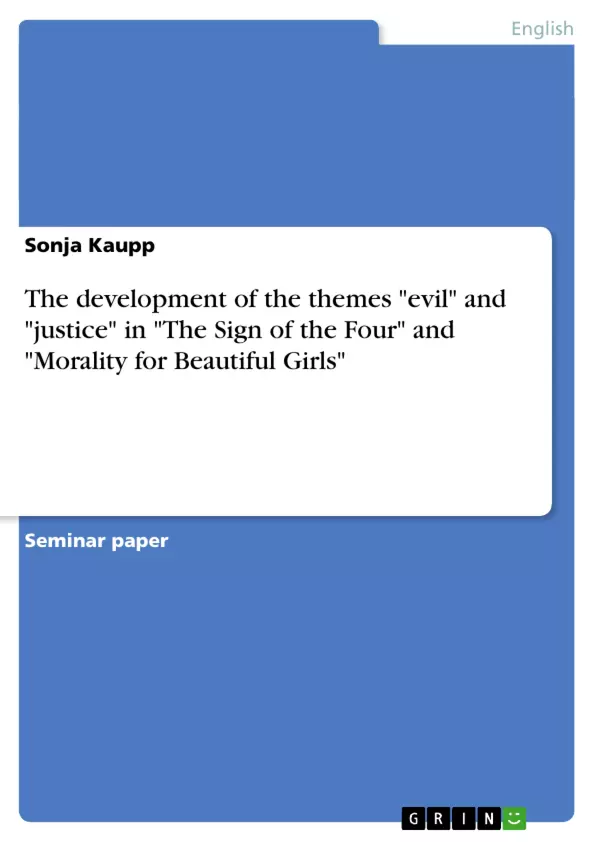The themes “evil” and “justice” are vital in detective fiction – without people committing evil deeds, there would be no need to employ detectives whose job it is to restore justice by identifying the criminals. However, this is only the basis for the plots. At the end of the novel we do get to know the villain, but by then we also know who was believed by the various characters to be that person.
In the two novels I chose, The Sign of Four by Arthur Canon Doyle, first published in 1890 and Morality for Beautiful Girls by Alexander McCall Smith, first published in 2001, these villains are greedy, seek revenge or are savage. People fear them because they feel they do not have any social control over them. I will also deal with anthropological criminology which is discussed in both novels, more or less obviously. Throughout the essay I will show how the detectives and their helpers are used to contrast the wrongdoers. Closely connected to the evil is the wish to restore justice. In both novels it is not the police or the judiciary that deal with this task. The detectives are needed to detect the wrongdoers and therefore they can decide how they will punish them – for example, it is their decision whether they want to take the matter to the police or not. Another statement that the novels make is the fact that evil people are punished directly by their own evil deeds, because they influence their later life.
Inhaltsverzeichnis (Table of Contents)
- 1. Introduction
- 2. Perception of evil persons
- 2.1 Selfish People
- 2.2 People seeking revenge
- 2.3 Indirect Revenge – “Evil in return”
- 2.4 The savage
- 2.5 Anthropological criminology
- 3. Restoration of Justice
- 3.1 The detection of evildoers – the detective’s job
- 3.2 The consequences of evil deeds
Zielsetzung und Themenschwerpunkte (Objectives and Key Themes)
This essay examines the themes of "evil" and "justice" in Arthur Conan Doyle's The Sign of Four and Alexander McCall Smith's Morality for Beautiful Girls. The analysis explores how these themes are developed through character portrayal and narrative structure, contrasting the actions and motivations of the villains with those of the detectives. It also investigates the role of anthropological criminology in shaping perceptions of evil and its implications for the restoration of justice.
- The portrayal of different types of evil (selfishness, revenge, savageness).
- The contrasting roles of the detectives (Holmes and Mma Ramotswe) in restoring justice.
- The influence of anthropological criminology on the narratives.
- The consequences of evil deeds and the possibility of forgiveness.
- The contrasting approaches to justice between the detectives and the police.
Zusammenfassung der Kapitel (Chapter Summaries)
Chapter 1: Introduction introduces the central themes of "evil" and "justice" in detective fiction and outlines the approach of the essay, focusing on the portrayal of villains in The Sign of Four and Morality for Beautiful Girls.
Chapter 2: Perception of evil persons delves into various manifestations of evil, exploring selfishness, revenge, indirect forms of revenge, and the portrayal of "savages." This section analyzes characters' motivations and actions, contrasting them with the actions of virtuous characters.
Chapter 2.1 - 2.4: These subsections detail specific examples of evil characters and their actions in the novels, exploring diverse motivations such as greed, revenge, and the lack of societal integration.
Chapter 2.5: Anthropological Criminology: This section examines the influence of Cesare Lombroso's theories on the narratives, contrasting their presence in the two novels.
Chapter 3: Restoration of Justice examines the detectives’ roles in restoring justice, highlighting the differences in approach between Holmes and Mma Ramotswe, and contrasting their methods with those of the police.
Chapter 3.1: The detection of evildoers: This subsection focuses on the detectives' jobs in uncovering evil and their methods.
Chapter 3.2: The consequences of evil deeds: This subsection discusses how the narratives portray the consequences of evil actions, considering both major and minor crimes, and the possibility of forgiveness.
Schlüsselwörter (Keywords)
Detective fiction, evil, justice, Sherlock Holmes, Mma Ramotswe, The Sign of Four, Morality for Beautiful Girls, anthropological criminology, Cesare Lombroso, greed, revenge, savageness, forgiveness, social control.
- Citation du texte
- Sonja Kaupp (Auteur), 2008, The development of the themes "evil" and "justice" in "The Sign of the Four" and "Morality for Beautiful Girls", Munich, GRIN Verlag, https://www.grin.com/document/123413



